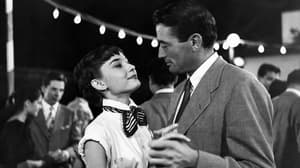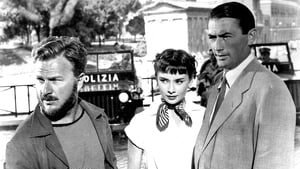Contact: [email protected]
Video Sources 0 Views

Synopsis
[ez-toc]





Introduction
In the heart of cinematic history lies a gem that has captivated audiences for decades – “Roman Holiday Colorized,” a classic film from 1953. This black and white masterpiece, directed by William Wyler, has recently undergone a transformative process: colorization. In this article, we delve into the charm and appeal of old films, exploring the significance of colorization in resurrecting the magic of “Roman Holiday Colorized.”
Read Media File Transfer Agreement: Terms and Conditions
Read FAQ
The Significance of Colorization in Old Movies
Cinematic treasures from the past have an undeniable allure, and “Roman Holiday Colorized” is no exception. Shot in the iconic Cinecittà studios, the film captured the essence of a bygone era. However, the transition from black and white to color breathes new life into these old frames. The concept of colorized movies has been a subject of both admiration and controversy.
Colorization, as a process, involves digitally adding color to monochrome films. This allows audiences to experience classic movies in a vibrant and contemporary way. For films like “Roman Holiday Colorized,” where the visuals play a pivotal role in storytelling, the colorization process becomes a bridge between generations.
During the Hollywood blacklist era, directors like William Wyler faced challenges in their careers. The colorization of “Roman Holiday Colorized” serves as a tribute to their resilience and creativity during a tumultuous period in the industry.
The Controversy Surrounding Colorizing Roman Holiday Colorized
The debate between black and white versus colorized films is as old as the art of filmmaking itself. Some argue that the authenticity and nostalgia of old movies are compromised when color is added. However, for “Roman Holiday Colorized,” a romantic comedy set against the enchanting backdrop of Rome, colorization brings forth a new layer of depth and emotion.
The film’s black and white palette conveyed a sense of timeless elegance, but the colorization adds warmth and vibrancy. The scenic beauty of Rome, Audrey Hepburn’s iconic wardrobe, and the chemistry between the lead actors, Audrey Hepburn and Gregory Peck, come alive in a way that transcends the limitations of monochrome.
The controversy surrounding colorization becomes particularly intriguing when analyzing its impact on the portrayal of comedic moments and romantic elements in “Roman Holiday Colorized.” Does the addition of color enhance or dilute the magic of a stolen scooter ride through the streets of Rome? The debate rages on.
Re-release, Reception, and the Film’s Legacy
The decision to colorize “Roman Holiday Colorized” was met with skepticism by purists, but it paved the way for a remarkable re-release. The restoration efforts not only brought the film back to its original glory but also introduced it to a new generation of cinephiles. The colorized version made its mark at prestigious events like the Golden Globe Awards and the Venice International Film Festival.
Audrey Hepburn’s portrayal of Princess Ann in “Roman Holiday Colorized” earned her an Academy Award for Best Actress. The colorized version’s critical reception at these esteemed ceremonies showcases the adaptability of classic films to contemporary tastes. Audrey Hepburn herself, in interviews, expressed both surprise and delight at seeing her iconic role in a new light, quite literally.
Insights from other cast and crew members further contribute to the film’s legacy. The colorized version has become a testament to the enduring charm of “Roman Holiday,” proving that a classic can evolve without losing its essence.
User Opinions: Exploring Audience Reactions to the Colorized Roman Holiday Colorized
As we explore the landscape of user opinions and reviews for the colorized version of “Roman Holiday Colorized,” it becomes evident that audiences have diverse perspectives on this cinematic experiment. Many appreciate the meticulous colorization process, praising the attention to detail in recreating the film’s aesthetic.
User reviews often incorporate details about the 1953 film “Roman Holiday,” providing context for those unfamiliar with the original masterpiece. The plot summary and insights into the cast and production help paint a comprehensive picture for readers who may be discovering this classic for the first time.
Audience reactions towards the colorization process vary. Some find it to be a refreshing update, breathing new life into familiar scenes. Others, however, argue that the black and white essence of “Roman Holiday” is sacred and should remain untouched. The chemistry between Audrey Hepburn and Gregory Peck is a recurring highlight, with fans expressing admiration for how the colorized version accentuates their on-screen connection.
In the realm of movie reviews, the colorized “Roman Holiday” has garnered positive feedback for its contribution to preserving the film’s history. It serves as a gateway for younger audiences into the world of classic cinema, sparking interest in other timeless films.
Preserving Film History: The Ongoing Debate on Colorization
As we reflect on the impact of colorization on old films like “Roman Holiday,” the question of preservation versus modification emerges. The ongoing debate raises concerns about maintaining the authenticity of cinematic history while catering to evolving tastes.
The official certification inquiry into colorized versions of classic films, including “Roman Holiday,” adds a layer of legitimacy to the discussion. Audrey Hepburn’s legacy, intertwined with her iconic role in the film, brings attention to the responsibility of preserving her artistic contributions.
In conclusion, the colorized “Roman Holiday” of 1953 opens the door to a broader conversation about the future of classic films. While purists may argue for the preservation of the original black and white aesthetic, the allure of colorization cannot be dismissed. As we navigate this cinematic crossroads, the potential for future releases of other classic movies in colorized versions remains a tantalizing prospect.
In the end, whether one embraces the colorized version of “Roman Holiday” or cherishes the black and white original, the undeniable truth is that this timeless tale of love and adventure continues to capture hearts across generations. The colorization debate may linger, but the magic of “Roman Holiday” endures, reminding us that, in the world of cinema, the past and present can coexist harmoniously.




















